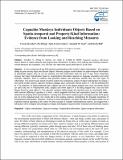Files in this item
Capuchin monkeys individuate objects based on spatio-temporal and property/kind information : evidence from looking and reaching measures
Item metadata
| dc.contributor.author | Kersken, Verena | |
| dc.contributor.author | Zhang, Da | |
| dc.contributor.author | Gomez, Juan-Carlos | |
| dc.contributor.author | Seed, Amanda Madeleine | |
| dc.contributor.author | Ball, Derek Nelson | |
| dc.date.accessioned | 2020-08-24T10:30:02Z | |
| dc.date.available | 2020-08-24T10:30:02Z | |
| dc.date.issued | 2020-08-01 | |
| dc.identifier | 269725328 | |
| dc.identifier | 6d1ec70c-0f3a-4fc4-8246-769b8d7df6ac | |
| dc.identifier.citation | Kersken , V , Zhang , D , Gomez , J-C , Seed , A M & Ball , D N 2020 , ' Capuchin monkeys individuate objects based on spatio-temporal and property/kind information : evidence from looking and reaching measures ' , Animal Behavior and Cognition , vol. 7 , no. 3 , pp. 343-364 . https://doi.org/10.26451/abc.07.03.06.2020 | en |
| dc.identifier.issn | 2372-5052 | |
| dc.identifier.other | ORCID: /0000-0002-7229-3282/work/79226699 | |
| dc.identifier.other | ORCID: /0000-0002-3867-3003/work/79226721 | |
| dc.identifier.other | ORCID: /0000-0002-0218-9834/work/79226811 | |
| dc.identifier.uri | https://hdl.handle.net/10023/20504 | |
| dc.description | This paper is an output of the project ‘Rethinking Mind and Meaning: A case study from a co-disciplinary approach’ (Award Nr.: AH/ L015234/1), funded by the Arts and Humanities Research Council (AHRC), as part of the Science in Culture Theme (http://www.sciculture.ac.uk). | en |
| dc.description.abstract | A core component of any folk physical understanding of the world is object individuation - the cognitive ability to parse sensory input into discrete objects. Whereas younger human infants use spatio-temporal information to individuate objects, they do not use property and kind information until one year of age. Some researchers propose that object individuation based on property/kind information depends on language acquisition and sortal concepts. However, there is evidence that preverbal infants and nonhuman animals also use both types of information. The present study aimed to further explore the evolutionary origins of object individuation by testing a new-world monkey species, capuchin monkeys (Sapajus spp.), using both manual search (n = 29) and looking time (n = 23) measures. In Spatio-temporal trials, subjects saw one or two objects dropped into a box, but always found (or saw) only one. In Property/kind trials, subjects saw either object A or B being dropped into a box and then always found (or saw) object A. The capuchin monkeys looked longer and searched more on inconsistent trials – with outcome differing in quantity or in kind - which suggested that they had expectations based on both spatio-temporal and property-kind representations. Looking time and search measures gave convergent results at the group but not at the individual level. Our results add to the existing evidence contradicting the linguistic hypothesis of property/kind individuation. However, contrary to recent discussions, we argue that these and related results can be explained without appealing to the notion of sortal concepts or multiple representational systems, and suggest that a full picture of the ontogeny and phylogeny of object individuation requires further empirical and theoretical research. | |
| dc.format.extent | 22 | |
| dc.format.extent | 640588 | |
| dc.language.iso | eng | |
| dc.relation.ispartof | Animal Behavior and Cognition | en |
| dc.subject | Object individuation | en |
| dc.subject | Capuchin monkeys | en |
| dc.subject | Property/kind information | en |
| dc.subject | Spatio-temporal information | en |
| dc.subject | BF Psychology | en |
| dc.subject | DAS | en |
| dc.subject.lcc | BF | en |
| dc.title | Capuchin monkeys individuate objects based on spatio-temporal and property/kind information : evidence from looking and reaching measures | en |
| dc.type | Journal article | en |
| dc.contributor.sponsor | Arts and Humanities Research Council | en |
| dc.contributor.institution | University of St Andrews. School of Psychology and Neuroscience | en |
| dc.contributor.institution | University of St Andrews. Institute of Behavioural and Neural Sciences | en |
| dc.contributor.institution | University of St Andrews. Centre for Social Learning & Cognitive Evolution | en |
| dc.contributor.institution | University of St Andrews. ‘Living Links to Human Evolution’ Research Centre | en |
| dc.contributor.institution | University of St Andrews. Philosophy | en |
| dc.contributor.institution | University of St Andrews. Arché Philosophical Research Centre for Logic, Language, Metaphysics and Epistemology | en |
| dc.identifier.doi | 10.26451/abc.07.03.06.2020 | |
| dc.description.status | Peer reviewed | en |
| dc.identifier.grantnumber | AH/L015234/1 | en |
This item appears in the following Collection(s)
Items in the St Andrews Research Repository are protected by copyright, with all rights reserved, unless otherwise indicated.

